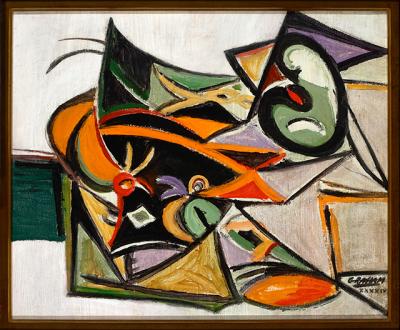John Graham's ‘Modern Maverick’ Retrospective

In 1930, the artist John Graham wrote to his patron and collector Duncan Phillips that “Stuart Davis, [Arshile] Gorky, and myself have formed a group and something original, purely American, is coming out from under our brushes.”
This from a man who was born Ivan Gratianovitch Dombrowski in Kiev, Ukraine, in 1886, served as a cavalryman in Czar Nicholas’s army, and did not begin studying painting until 1923.
Graham immigrated to New York in 1920 and had established himself as an integral and influential figure in the world of modern American art by the time he wrote that letter to Phillips.
In an effort to illuminate Graham’s importance, on Sunday the Parrish Art Museum in Water Mill will open “John Graham: Maverick Modernist,” the first retrospective of his work in 30 years.
“He was often seen as a total eccentric and an outlier,” said Alicia Longwell, the Parrish’s chief curator and organizer of the exhibition. “My hope is to depict him as a player, a fully integrated painter, and to present more of a nuanced picture of who he was and what he meant to young painters during the 1920s and 1930s.”
The exhibition will include 60 paintings and a selection of works on paper drawn from 40 private and public collections, including those of the Museum of Modern Art, the Metropolitan Museum of Art, the Phillips Collection, the Museum of Fine Arts, Houston, and the Baltimore Museum of Art.
Graham registered in John Sloan’s life-painting classes at the Art Students League in 1923. Fellow students included Alexander Calder, Barnett Newman, and Adolph Gottlieb. In addition to meeting those artists, Graham was introduced by Sloan to Frank Crowninshield, the editor of Vanity Fair. Graham eventually collected art for Crowninshield, as he did for Phillips, Helena Rubinstein, and others.
The exhibition will open with “Self-Portrait” from 1923. Throughout the
’20s, Graham’s paintings, along with those of Gorky, Davis, John Marin, Patrick Henry Bruce, and Alfred Henry Maurer, “were key in rejuvenating American Cubism,” according to the art historian William C. Agee, who contributed an essay to the exhibition catalog. At the same time, Graham drew and painted in a more figurative manner.
In the ’30s he moved in the direction of abstraction, with still-life paintings that used a minimum of color and linear forms, though he did not completely abandon figuration, as reflected in his 1939 portrait of Anni Albers.
In the ’40s, “he came to a sort of impasse,” Ms. Longwell said. “He saw what [Willem] de Kooning was doing, he saw what [Jackson] Pollock was doing, and he set up this idea of taking abstraction as far as he could. But he would never go on to the breakthrough of Abstract Expressionism. Soon after, he did a complete reversal” and began to paint figuratively.
In 1946, Graham had shows at the Pinacotheca Gallery and in the windows of the Arnold Constable department store, both in Manhattan. It was the first time his new classical style had been seen, and many people didn’t know what to make of it. “In my book, those works certainly look back, but they are certainly Modernist,” Ms. Longwell said. “The reaction was a bit like when Philip Guston turned figurative.”
Also at this time, Graham turned against Picasso, and produced a four-page diatribe in which he called Picasso’s art a hoax. He went on to ask, “Would it not be more modern and progressive to keep on the road of evolutionary development from the point where the old masters left off?”
In 1943 he met Marianne Strate, the mother of Ileana Sonnabend, and they remained together until her death in 1955. In 1951, she bought a house at 220 South Main Street in Southampton, and during the ’50s Graham was connected to the East End artists’ community, counting among his friends Pollock, Lee Krasner, Willem and Elaine de Kooning, Fairfield Porter, and Leo Castelli.
Graham died in London of cancer in 1961. As Ms. Longwell points out in her chronology of his life, just before his death he wrote in a diary: “I brought culture to the U.S. and didn’t even have a social security card.”
The exhibition will trace the various developments in his work while also, through Ms. Longwell’s chronology, enumerating the many artists, collectors, and cultural icons who figured so prominently in his world. “John Graham: Modern Maverick” will be on view through July 9.
